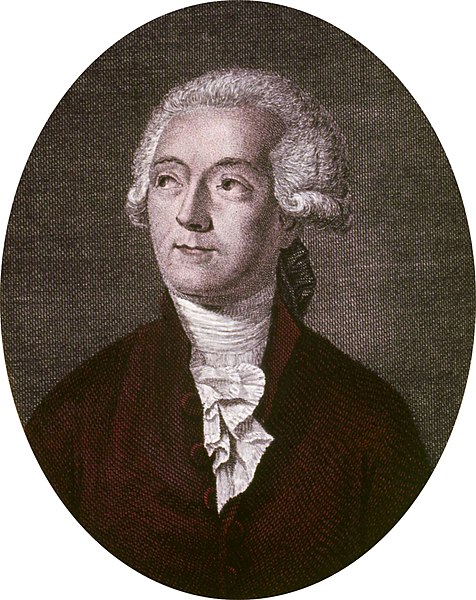
Image by David from Wikimedia
Top 10 Unbelievable Facts about Antoine Lavoisier
“In nature, nothing is created, nothing is lost, everything changes.” this is a famous quote made by Antoine Lavoisier.
He was a French nobleman and a prominent chemist, who revolutionized chemistry and the history of biology as we know it today.
Antoine Lavoisier was born in Paris, France on August 26, 1793, to a wealthy family of nobility. His parents were Emilie Punctis and Jean Antonie Lavoisier, an attorney at the Parlement of Paris.
He is most famous for his discovery of the role oxygen plays in combustion. Here are the top 10 unbelievable facts about him.
1. Antoine Lavoisier Inherited a huge Fortune at the age of 5

Image Source: Wikimedia
Antonie Lavoisier was born and raised in an affluent family of nobles in Paris. His father was a prominent lawyer in Paris, while his mother was a rich woman who brought a substantial amount of money as her wedding dowry.
His mother died when he was only five years old, and she left a huge fortune for him as an inheritance. He was raised by his aunt Constance Punctis, who secured him the best schools in Paris at that time.
2. Antoine Lavoisier Graduated with a Law Degree
It is interesting to note that the most prominent chemical scientist in the History of France, actually studied law in college.
Lavoisier began his schooling at the Collège des Quatre-Nations, the University of Paris (also known as the Collège Mazarin) in Paris in 1754 at the age of 11.
In his last two years at the school, Lavoisier developed a big interest in science, and he studied mathematics, astronomy, botany, and chemistry.
Lavoisier later joined the school of law, where he graduated with a Bachelor’s degree in 1763. He received a license and was admitted to the bar in 1764, but he never practiced law as his interest was in science.
3. Antoine Lavoisier was a Humanitarian
Although Lavoisier is widely known for his contributions to the sciences, he was also a dedicated Humanitarian. He cared deeply about people’s welfare and he spent his time and money trying to improve people’s standard of living.
His area of focus was in the water, sanitation, agriculture, industry, and sciences. His first humanitarian activity was when he submitted an essay on improving urban street lighting to the French Academy of Sciences in 1765.
In 1768, he focused on a project to bring drinking water to the citizen of Paris from the River Yvette. He later embarked on purifying water for people to drink from the river.
4. Antoine Lavoisier Financed Science Projects
Lavoisier was very passionate about public education in the sciences; he was also a fairly rich person by the French standard of that time. He had gained a vast majority of his income through buying shares in the General Farm.
In the 18th century, it was very difficult to secure public funding for the sciences from the government. Lavoisier used his own resources to finance the establishment of a very expensive and sophisticated laboratory in France.
This was to help aspiring scientists study for free without the worry of raising funds to finance their research. He also founded two organizations funded by the wealthy to finance the development of science education.
5. Antoine Lavoisier Married A 13 years old Girl

Photo by Metropolitan Museum of Art from Wikimedia
In 1771 at age 28, he married Marie-Anne Pierrette Paulze, the 13-year-old daughter of a senior member of the Ferme générale.
At the age of 26, Lavoisier bought shares at Ferme générale, an outsourced tax collector on behalf of the king. The company was immensely rich and very unpopular with taxpayers.
Marie-Anne Pierrette Paulze was a French chemist and noblewoman like Lavoisier. She acted as his laboratory companion and contributed to his work.
She played a pivotal role in translating Lavoisier’s scientific works to the English language and was instrumental in the standardization of the scientific method.
6. Antoine Lavoisier Discovered the Role of Oxygen in Combustion
Lavoisier is famous for his discovery of the role oxygen plays in combustion. It was the biggest single contribution he made to science, in his entire career.
He observed that all substances gain weight during combustion, and concluded it was due to the same reason that the weight increased in all substances.
He recognized and named oxygen (1778) and hydrogen (1783), and opposed the phlogiston theory. Lavoisier helped construct the metric system and wrote the first extensive list of elements.
7. Antoine Lavoisier Published First Chemistry Book

Image Source: Wikimedia
Lavoisier published a textbook titled Traité élémentaire de chimie in 1789. The book represents the synthesis of Lavoisier’s contribution to chemistry.
The text clarified the concept of an element as a substance that could not be broken down by any known method of chemical analysis and presented Lavoisier’s theory of the formation of chemical compounds from elements.
The textbook was translated into English within the first year of its publication. It remains a classic in the history of science, and the first chemistry textbook to be published.
8. Antoine Lavoisier was Executed
In height of the French Revolution in the 1790s, the unpopular Ferme général was abolished. Lavoisier was forcefully removed from his post on the gun powder commission.
The order to arrest all former members of the Ferme general was issued. Lavoisier and other tax farmers faced nine counts including scam to the state exchequer and adulteration of tobacco with water.
Despite Lavoisier’s well-drafted defense against the accusations, He was convicted together with other 27 co-defendants and was guillotined on 8 May 1794 in Paris.
9. Antoine Lavoisier was Wrongly Convicted
Lavoisier was completely exonerated of any wrongdoing by the French government, one year, and a half after his execution. His personal belongings were delivered to his widow, with a brief note that read “To the widow of Lavoisier, who was falsely convicted”.
One century after his death, a statue of Lavoisier was erected in Paris. It was later discovered that the sculptor had used the wrong copied head for the statue.
10. Antoine Lavoisier was Honoured Posthumously

Photo by Chambe01 from Wikimedia
Although Lavoisier was awarded a gold medal for his work by the King of France during his lifetime, his contribution to science was recognized much later after his death.
Lavoisier’s work was recognized as an International Historic Chemical Landmark by the American Chemical Society, Académie des sciences de L’institut de France and the Société Chimique de France in 1999.
His 1788 publication with his colleagues was honored by a Citation for Chemical Breakthrough Award from the Division of History of Chemistry of the American Chemical Society in 2015.
It is over 200 years since Antoine Lavoisier was wrongly convicted and executed, but his contribution is of great influence to the world of science today.
.
.
Planning a trip to Paris ? Get ready !
These are Amazon’s best-selling travel products that you may need for coming to Paris.
Bookstore
- The best travel book : Rick Steves – Paris 2023 – Learn more here
- Fodor’s Paris 2024 – Learn more here
Travel Gear
- Venture Pal Lightweight Backpack – Learn more here
- Samsonite Winfield 2 28″ Luggage – Learn more here
- Swig Savvy’s Stainless Steel Insulated Water Bottle – Learn more here
Check Amazon’s best-seller list for the most popular travel accessories. We sometimes read this list just to find out what new travel products people are buying.









